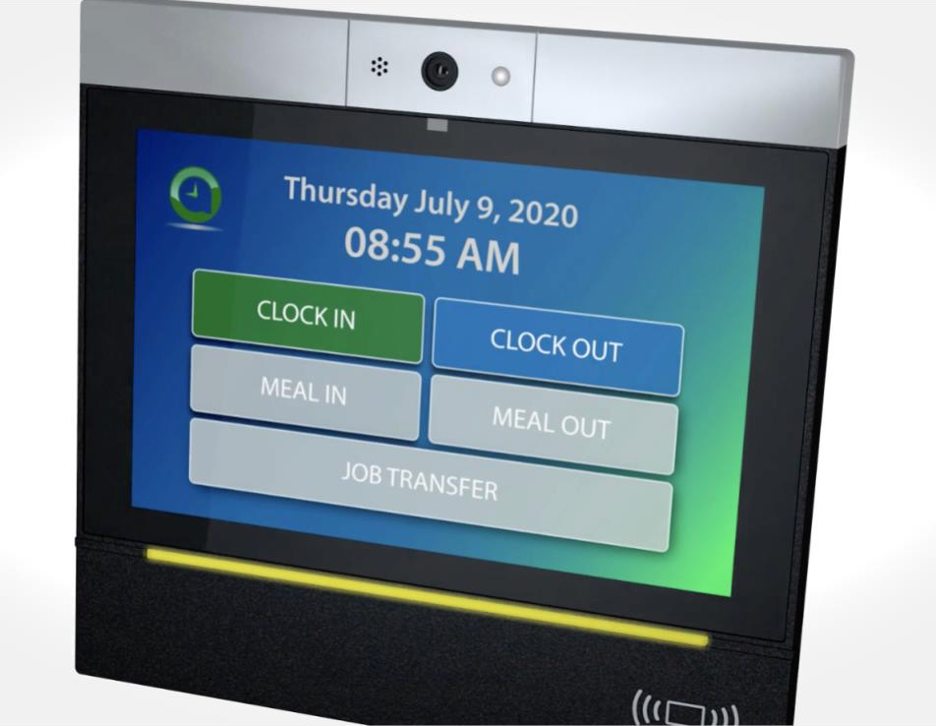The Right Middleware Makes Updating Time Clock Systems Easy
Total cost of ownership (TCO) is a huge factor companies consider when calculating the ROI they can expect when working with you and your software solution. As you decide what time clocks to resell, consider the TCO of the time clocks, including how vendor support impacts your own TCO.
When calculating TCO for a time clock, a big consideration is the resources and time your company will expend, ensuring it’s operating reliably and securely. How quickly can you roll out an urgent security patch to every time clock sold to every one of your customers? How reliable is the data flow between your system and all the time clocks? Can you monitor the integrations between your customers’ time clocks and your software?
Is the time clock management easier and more efficient as you scale, or more cumbersome and expensive?
How you answer these questions about any time clock depends on the middleware you use to manage your time clocks across all your customers. The right middleware will carry most of the management burden for you, keeping your TCO of the time clocks down. Even better, the lower TCO on your time clocks boosts your profitability by reselling them and your customers’ ROI on your system.
The middleware manages all the data and communication between your system and your customers’ time clocks. It should be able to automate much of that work and make it easy for your support team to roll out time clock changes at scale quickly.
Why Your Solution Needs Middleware to Integrate with Time Clocks
The middleware layer is software that sits between the time clocks and your solution. It’s the weigh station where all data and communication must go before continuing on to its destination.
It would be near impossible for your system to easily integrate with each time clock directly, certainly not in a way that ensures smooth operations and low costs to manage.
Middleware Functionality
The primary function of the middleware is to facilitate data sharing and communication. All the employee attendance data collected at the time clock is sent to the middleware, which sends it to other systems, such as payroll and workforce management.
When your system gets updated employee data and sends it to the middleware, the business rules set on the middleware determine how that information is shared to the time clocks. When a new employee is hired, clocks sometimes need that employee’s information, but others will not. Middleware configured with business rules automates the proper distribution of employees’ information.
You don’t want all of your end-user employees’ information available on each time clock. You want to keep your end users’ data and information separate for security and compliance reasons. Grouping time clocks and employees logically on the middleware so data can be automatically distributed based on business rules is critical to enabling them to operate more efficiently.
The middleware’s ability to manage distribution to time clocks also allows efficient time clock configuration and security updates. If a customer wants to update time clock functionality or there’s a new time clock software version, the middleware should easily push that out to countless time clocks in minutes.
AccuCloud is the Easy and Profitable Solution
AccuCloud is our cloud-based time clock attendance data collection and management system for resellers interested in reselling a bundled solution that includes an integration to their back end with AccCcloud, to their customers. Its middleware is the core component that enables communication and action among all the other pieces.
The AccuCloud components, in addition to the middleware, include:
1. Time clocks: You can select from a number of ATS time clocks and employee ID reader options, including card and biometric readers, to resell.
2. Web management portal: The portal is your team’s access window to monitor time clocks and their integration with your system in real-time.
We built the AccuCloud middleware to perform complex functions, automating as much data and communication flows as possible and making it easy to set up and kick off tasks that aren’t fully automated. The scope of functionality any middleware software has depends on how it was built. AccuCloud middleware is a powerful example of what you should expect from a middleware layer. You can build your own middleware or license it from another vendor. In that case, we highly recommend you clarify your functionality requirements. Then closely examine the middleware you’ll rely on to manage the integration with your system, to ensure it operates in a way that makes time clock management at scale easy and cost-effective.
Rapid Clock Updates Ensures Accurate Employee Payroll
Employee information constantly changes. Employees move to new locations or departments, or both simultaneously. People leave, and new employees take their place. These daily employee information changes need to get out to the time clocks quickly to minimize the need for manual record-keeping and payroll hours reconciliation.
The middleware that automates the proper distribution of new and changed employee information and expedites time clock updates provides significant value to your customers’ employee attendance management systems.
The TimeClock Will Always Have Employees’ Current Information Needed by Payroll
Time clocks need the most current employee information to make sure that the payroll system gets all the information it needs to pay employees, and calculate taxes and benefits accurately. Here are just a few use cases where employee information changes will result in changes to how their pay is calculated. These use cases can also impact the integrity of other systems and processes.
1. Departmental Transfers: An employee gets loaned out part-time to a different department. Every time an employee clocks in, they must identify which department they’re clocking in for. The employee may get paid a different hourly rate based on the department. The company may track internal chargebacks among departments, so its accounting system needs to know what hours employees spent working for different departments.
2. Employee Status Updates: New hire information needs to get out to the time clocks quickly. Companies want new employees clocking in from their first shift, so no manual record keeping is necessary. Separated employees must be removed from the time clocks quickly so they can’t continue to clock in and perhaps receive inflated final pay.
3. Location Groupings: The workforce is getting more mobile. Employees can work at multiple sites for the same company. The move to a new position within the company may come with a move to a new location. Since each location has its own set of labor, tax, and fair pay laws, it’s vital that the payroll system knows where an employee worked each hour. Time clocks can be grouped by location, so the exact location is attached to each attendance punch record. Employees are also grouped by location to make their information available at all the time clocks where they need access.

AccuCloud middleware automates how all this information gets updated through its integration with your system and the configuration setup. Consequently, your customers can be confident that their payroll system gets only the most current information for a clean payroll run.
Cloud-Based Time Clock Management Works Where Mobile Time Tracking Can’t
Many customers can’t or won’t allow mobile time clocks at work. Mobile time clocks come with a host of security and operational issues that raise the costs and stress of managing an attendance system.
One of the challenges with mobile time tracking is ensuring the correct work location is attached to every working hour. As discussed above, the payroll process must have work location data to calculate proper pay.
The main goal of automating time and attendance is to avoid the need for any manual intervention by payroll staff before running payroll. That requires time clocks that can get quickly updated through cloud-based middleware to collect accurate work locations for a mobile workforce.
Middleware Provides Time Clock Software Configuration Flexibility
In addition to accurate employee data, companies may want additional information for internal
reporting needs – and you want to offer them that flexibility. With middleware managing time clock software configuration, you can respond quickly to customer requests, such as tracking meal breaks or project chargebacks. Our deep experience in employee time tracking has taught us what companies want. So we’ve already built that functionality into the middleware and time clock software, allowing us to turn it on for your customer shortly after they request it.
Take Control of System Updates without Touching a Time Clock
A great challenge of time clock fleet management is keeping all devices current and on the same software versions, and keeping everything secure – especially as the number of devices scales up.
How Middleware-Managed Updates Lower TCO
Companies waste a ton of admin hours managing oversight of software versions. Then, they waste more time individually updating each piece of hardware.
The higher cost – and risk – are devices that aren’t running the most current security patches and upgrades. Using middleware to handle version and configuration updates virtually eliminates all these costs.
A cloud-based middleware, like AccuCloud’s, handles all system updates without requiring direct handling of the time clocks or other hardware. Our team can manage middleware and time clock updates for our partners, providing you the option to be completely focused on your business.
How OTA AccuCloud Updates Work
AccuCloud uses over-the-air (OTA) updates, which lets it deliver any operating system, software, or security update wirelessly. When ATS rolls out a new version or patch for time clocks, we inform all our partners in advance.
Other than security updates, which can go out immediately, our partners can schedule updates for their time clock fleet within the update window the ATS support team has set, or you can push out the updates to your customers yourself using the admin tools we provide. Most rollouts don’t disrupt the time clock or integration operations. For those that have a short downtime, usually under ten minutes, we work with partners to schedule during off or low activity hours.

Setting Up Middleware Integration
The typical AccuCloud implementation process runs around eight to twelve weeks. When you become an AccuCloud resale partner, we create an AccuCloud environment for you on our secure servers. All your customers’ installations will be part of your AccuCloud environment.
There are two main parts to the middleware setup:
1. Configure your middleware:
During this process, you’ll set up the time clock and employee groupings and their related business rules you want the middleware to handle, like ensuring meal break time is recorded so your customers’ payroll run doesn’t accidentally pay employees for extra time because they clocked in early from an unpaid meal break.
You’ll also identify the company and employee data sets the time clock needs to collect complete and accurate attendance information. For example, a company that uses biometric readers must set up groupings and data sets to manage template distribution.
2. Set up the integration with your system: You can set up an API/web service integration or use data loads to share data between the time clocks and your system.
How a Quick Integration Process Lowers TCO
The initial setup and integration of a middleware-run employee time collection system is a necessary, up-front cost to implementing any new system. The key is ensuring the process is thorough and streamlined to minimize the direct and resource costs required.
The AccuCloud middleware was designed and built strictly to integrate and manage ATS time clocks with external payroll and workforce management systems. Thus, we’ve deployed a rapid, stress-free implementation process that keeps costs down and allows fast access to all the advantages of a complete, cloud-based automated employee attendance data collection solution.

ATS Middleware Makes Reselling Time Clocks Easier and More Profitable
Reselling a complete solution like AccuCloud, with advanced middleware, lowers your TCO and enhances your system’s value to customers. Using the right cloud-based middleware to manage time clocks also keeps you responsive to customers’ needs, improving your customer experience. This all combines to increase your customers ROI and your lifetime customer value, making reselling cloud-managed time clocks a profitable double win.


